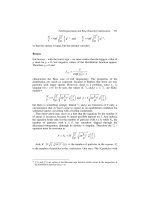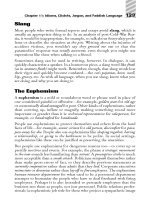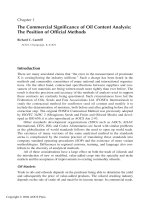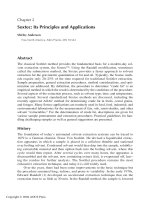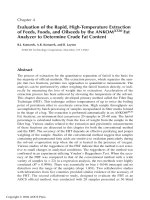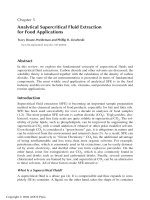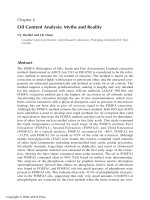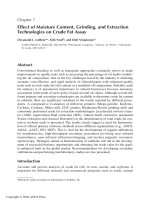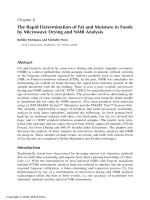oil extraction and analysis phần 7 ppt
Bạn đang xem bản rút gọn của tài liệu. Xem và tải ngay bản đầy đủ của tài liệu tại đây (565.72 KB, 19 trang )
Chapter 7
Effect of Moisture Content, Grinding, and Extraction
Technologies on Crude Fat Assay
Devanand L. Luthria
a,
*, Kirk Noel
b
, and Dutt Vinjamoori
c
a
USDA/ARS/FCL, Beltsville, MD 20705;
b
Monsanto Company, Ankeny, IA 50021;
c
Monsanto,
St. Louis, MO 63167
Abstract
Conventional breeding as well as transgenic approaches constantly strives to make
improvements to quality traits such as increasing the percentage of oil and/or modify-
ing the oil composition. One of the key challenges faced by the industry is obtaining
accurate, cost-effective, and rapid analysis of oilseeds/grains with enhanced quality
traits such as total crude fat (oil) content or a modified oil composition. Reliable crude
fat analysis is of paramount importance to oilseed businesses because monetary
assessment in the trade of such seeds is based on total oil values. Although several dif-
ferent primary and secondary technologies are available to determine crude fat content
in oilseeds, there are significant variations in the results reported by different proce-
dures. A comparative evaluation of different grinders (Mega-grinder, Knifetec,
Cyclotec, Cemotec, Mikro mill, UDY grinder, Brinkmann-Retsch grinding mill) and
commonly performed crude fat extraction methodologies [accelerated solvent extrac-
tor (ASE), supercritical fluid extraction (SFE), Ankom batch extraction, automated
Soxtec extraction and classical Butt-tube] on the determination of total crude fat con-
tent in soybean seeds is presented. The results clearly suggest a need for harmoniza-
tion of official primary reference methods across different organizations (e.g., AOCS,
AOAC, AACC, ISO, DGF). This is vital for the development of rugged calibrations
for nondestructive, high-throughput secondary procedures involving near infrared
transmittance, near infrared reflectance/imaging, and nuclear magnetic resonance
spectroscopy. Strategies aimed at harmonization of methods will aid in the develop-
ment of successful business opportunities and obtaining fair trade value for the quali-
ty-enhanced traits in the global market. Recommendations for developing secondary
calibrations and performing interlaboratory studies are also presented.
Introduction
Accurate and precise analysis of crude fat (oil) in corn, canola, and soybeans is
important for different research and commercial programs such as seeds, animal
*Research work was done at Monsanto in Ankeny, IA.
Copyright © 2004 AOCS Press
feed trade, nutritional labeling, and biotechnology research. Reliable assays of quality
and quantity of crude fat content in oilseeds/grains are essential for determination of
the fair trade value of enhanced traits/products in the global market. To facilitate this
process, several international societies such as the American Oil Chemists’ Society
(AOCS) (1), the Federation of Oil Seeds and Fat Association Ltd. (FOSFA) (2), the
German Fat Science Society (Deutsche Gesellschaft fur Fettwissenschaft, DGF) (3),
the International Organization of Standardization (ISO) (4), the American Association
of Cereal Chemists (AACC) (5), and the Association of Official Analytical Chemists
(AOAC) (6) have developed standard reference methods for the assay of quality and
quantity of crude fat in a variety of matrices. Nevertheless, problems exist because of
inherent variations in the method practiced.
The common approach for total crude fat determination is based on the solu-
bility of lipids in nonpolar organic solvents such as hexanes, petroleum ether, or
supercritical liquid carbon dioxide with or without a solvent modifier. The volatile
solvents are removed by evaporation and the nonvolatile residue (crude fat) is mea-
sured gravimetrically. The nonvolatile fraction consists of triacylglycerols and
trace amounts of other components such as free fatty acids and their alkyl esters,
sterols, sterol esters, long-chain aldehydes and alcohols, fat-soluble vitamins, and
other nonpolar natural products. Alternatively, two high-throughput nondestructive
methods that utilize nuclear magnetic resonance and near infrared spectroscopic
techniques have also been developed. These methods are secondary in nature
because they require calibration support by primary reference methods (7–9). In
response to the U.S. 1990 Food Labeling Act, another reference method was devel-
oped to measure crude fat content (10). In this approach, fat was defined as the
sum of all fatty acids present in a food material expressed as triacylglycerol equiv-
alents of all analytically measured fatty acids.
Three factors that affect crude fat analysis are moisture content, sample prepa-
ration, and extraction methodologies. Accurate moisture content determination in
oilseeds is essential because it plays a crucial role in determining the monetary
value of the oilseeds and appropriate storage conditions. There are several primary
(Karl Fischer, Brown-Duvel, gas chromatography, air-oven drying, and phospho-
rous pentoxide), and secondary technologies (near infrared, nuclear magnetic reso-
nance, and conductance- and capacitance-based moisture meters) used for analyses
of moisture content in grains. A variety of methods exists that have been approved
by different official societies. These methods differ in variables such as the drying
temperatures, drying time, or sample quantity used for moisture determination. All
of these factors have differing effects on moisture content determination, and this
indirectly affects assays of crude fat, protein, fiber, and other constituents. Details
of factors affecting the precision of moisture measurement (grinding, sample size,
moisture dishes, ovens, relative humidity of the laboratory, desiccant) and different
moisture reference methods were summarized in two publications (11,12).
We chose to evaluate two factors that affect the crude fat assay, i.e., the influence
of sample preparation (the grinder study) and crude fat extraction methodologies.
Copyright © 2004 AOCS Press
There have also been a number of publications comparing different extraction proce-
dures on crude fat assay (10,13–15); however, all of the earlier studies except our
preliminary report were carried out with one sample from each grain variety and
comparison with the Ankom batch extraction process was not evaluated earlier.
Several soy samples with varying crude fat content were ground on different
grinders under varying grinding conditions to examine the effect of sample prepa-
ration on crude fat assay. The comparative performance of five currently used oil
extraction technologies was also evaluated. This study was conducted to identify
the most accurate and precise method for bulk sample (sample size >500 mg) and
single-seed (sample size <150 mg) analysis. Sample extraction was conducted
using two different sample sizes. To determine the effect of different drying condi-
tions, the fatty acid composition of the oil extracted and dried at different temperatures
and conditions was also evaluated.
Experimental
Effect of Sample Preparation (Grinder Study)
The principle of operation of the seven grinders used for sample preparation is
summarized below.
Mikro Mill (Hosokawa). This is a high-capacity hammer mill designed for grind-
ing a comprehensive range of materials. Grinding is caused by impact between the
rotating hammers, particles, and deflector liner mounted in the mill housing cover.
The particle size of the ground material depends on the type of hammer, the rotor
speed, and the size of the screen opening. In the present study, a 1-mm screen size
was used (16).
Knifetec Grinder (Foss). This grinder utilizes a high-speed (20,000 rpm) rotor
blade for grinding samples. The particle size of the ground material depends on the
grind time and the number of cycles. The Knifetec grinding chamber is equipped
with a cooling feature that enables it to be connected to cold tap water or other lab-
oratory chilling devices. Samples containing high levels of fat have a tendency to
stick to the wall of the chamber because the fat softens during grinding, thus pre-
venting adequate homogenization. In addition, fibrous samples may generate heat
due to friction. Utilizing the cooling option, the Knifetec grinder overcomes both
of these problems to ensure satisfactory sample preparation (17).
Cemotec Grinder (Foss). This is a disc-type grinder that uses two discs, one sta-
tionary and one rotating. This is a fast grinder, allowing sample to be ground in <1
min. Although it is a fast grind, the particle size is very coarse even with the finest
setting on the instrument. Grinder settings range from 1 (finest grind) through 7
(coarsest grind) (17).
Copyright © 2004 AOCS Press
Cyclotec Grinder (Foss). This is a cyclone-type grinder that utilizes a high-speed
turbine that spins seeds against a coarse chamber ring. This action causes the seeds
to form a fine powder, which is pushed through a screen (1 or 2 mm). Samples
containing high levels of fat have a tendency to stick to the screen and eventually
block the passage of the sample through the screen. This grinder requires frequent
cleaning, thereby increasing the sample preparation time (17).
Mega-Grinder (built in-house at Monsanto). This is a ball-type grinder that con-
sists of a 2-horse power electric motor that drives a crankshaft via a belt. The
crankshaft drives a piston that holds the sample trays. The piston is moved in an
up-down motion. The sample is loaded into a sealed Delrin tube with a steel ball.
This grinder utilizes extremely rapid shaking (up to 3000 strokes/min) to drive the
steel balls into intact seeds causing seeds to become pulverized in 0.5–2 min. This
grinder has the capacity to grind 96 single-seed samples at one time in 2 min with
no cross-contamination.
UDY Grinder (UDY). This is a cyclone sample mill designed for rapid grinding
of a wide variety of soft to medium-hard materials. The grinding process involves
the high-speed rotation of the impeller and air currents that throw particles into the
grinding ring and rolls them around. Particles remain in the grinding chamber until
impact shattering and abrasion make them small enough to flow out of the exit screen
(2 mm) with the air current. The airflow removes essentially all material and makes
clean-out unnecessary. The airflow also minimizes heating and therefore eliminates
thermal degradation (18).
Brinkmann-Retsch Mill (Brinkmann). This grinder consists of a two-speed
motor, removable lid, rotors, and sieves. It is a centrifugal grinder that operates
similarly to the Cyclotec and UDY grinders (19).
Experimental Details for the Grinder Study
Sample Preparation. Seven soybean samples with varying oil content were used to
compare the effect of grinding and particle size on crude fat assay from ground soy-
beans. Grinding with Cemotec, Cyclotec, and the Mega-grinder was done at
Monsanto’s Crop Analytics Laboratory in Ankeny, IA. Samples were ground with the
Mega-grinder at two Monsanto sites (St. Louis and Ankeny) to evaluate instrument-
to-instrument variation. Samples for the Cyclotec were ground with 1- and 2-mm
screens. Samples were submitted to the contract laboratories for grinding on UDY,
Knifetec, and Mikro-mill grinders. Samples ground on a Knifetec mill were ground
for either 30 or 90 s; ~150 ± 1 g of each sample was submitted for grinding.
Extraction. Blind replicates of all ground samples were extracted in triplicate for
oil analysis by Soxtec extraction procedure. Moisture analysis on the ground sam-
ples was performed by an oven-drying procedure (AOCS Ac 2-41).
Copyright © 2004 AOCS Press
To evaluate the effect of particle size on crude fat analysis, a single soybean sam-
ple (~450 gm) was ground on a Cemotec grinder and Mega-grinder to provide a wide
range of particle size distribution. The combined ground sample was sieved using
multiple stacked sieves (1.4, 1.0, 0.6, and 0.3 mm). Approximately 30 g of ground
sample was placed on the top 1.4 mm mesh size sieve. The sample was brushed
through each sieve to eliminate/reduce the effect of sample caking. After brushing,
fractions were collected from the top of each mesh sieve and the bottom tray below
the finest mesh sieve. Each fraction was weighed separately to determine the particle
size distribution. Each of the fractions was analyzed for crude fat assay.
Experimental Section for Comparison of Five Extraction Procedures
Three soybean samples with varying oil content (19–23%) were used to compare
the extraction of crude fat by five different methods. To eliminate the effect of par-
ticle size on crude fat extraction yield, all seeds were ground with the Mega-
grinder, and these ground samples were used for analysis. Six replicate analyses
were carried out for each sample by all five methods. The results are reported on a
dry matter basis to eliminate the effect of varying moisture content. Extractions
with supercritical fluid extraction (SFE) were performed at ISCO Labs, and part of
the extractions with the Ankom batch procedure was performed at the Ankom
facility.
Extraction was done with two sample sizes, 100 mg and 1 or 2 g. Extraction
with 100-mg sample size was conducted to evaluate the applicability of the method
to single-seed analysis, whereas gram quantity sample size extraction was per-
formed with different samples as recommended by the instrument vendors [Soxtec
(1 g), Butt-tube (2 g), accelerated solvent extractor (ASE; 1 and 2 g), Ankom (500
mg), and SFE (2 g)]. Extraction conditions and sample processing for two sample
sizes (100 mg and 1–2 g samples) were the same for all methods. The five extrac-
tion procedures are summarized briefly below.
Butt-Tube Method. Extraction with the Butt tube is a single-step process that
involves continuous flow of distilled condensed solvent over the ground sample
matrix (4–5 h). The amount of oil extracted is determined gravimetrically after
evaporating the extraction solvent (AOCS Ac 3-44) (1).
Soxtec Extraction (Foss). This method is a two-step process for the extraction of
crude fat from ground samples. In the first step, the thimble containing the test por-
tion is immersed in the boiling solvent. The intermixing of the matrix with the hot
solvent ensures rapid solubilization of extractables. Then the thimble is raised
above the solvent and the test portion is further extracted by a continuous flow of
condensed solvent. The resulting crude fat residue is determined gravimetrically
after evaporation of the solvent.
The apparatus includes the following: (i) solvent extraction system (Soxtec 2050)
with multiple extraction units for conducting a 2-stage Randall extraction process with
Copyright © 2004 AOCS Press
solvent recovery cycle, using Viton or Teflon
TM
seals compatible with hexanes; (ii)
cellulose thimbles and a stand to hold the thimbles; (iii) extraction cups, which can be
aluminum or glass. (Extraction temperature settings may differ; consult manufactur-
er's operating instructions.) The reagents include hexanes and defatted cotton.
The determination is made as follows: Weigh 1 g of ground soy sample into tared
cellulose thimbles. Record the weight to the nearest 0.1 mg (S) and the thimble num-
ber. Place a defatted cotton plug (with solvent used for extraction) on top of the sam-
ple to keep the material immersed during the boiling step and to prevent any loss of
the sample from the top of the thimble. Prepare a cotton plug large enough to hold the
materials in place yet as small as possible to minimize the absorption of solvent.
Extract the sample with the following instrument settings: hot plate temperature, 163
±5°C; boiling time/sample immersion cycle time, 20 min; sample rinse cycle time, 40
min; solvent evaporation and recycling time, 8 min. Dry the sample cups at 105 ± 5°C
for at least 30 min before transferring to a desiccator and cooling to room temperature.
Weigh the empty sample cups (T) and the extraction cups and record the weights to
the nearest 0.1 mg.
Preheat the extractor and turn on the condenser cooling water. Attach thimbles
containing dried test portions to the extraction columns. Add a sufficient amount of
solvent (80 ± 10 mL) to each extraction cup to cover the sample when thimbles are in
boiling position. Place the cups under the extraction columns and secure in place.
Make sure that the cups are matched to their corresponding thimble. Lower the thim-
bles into the solvent and boil for 20 min. Verify proper reflux rate. Reflux rate is criti-
cal to the complete extraction of fat. Adjust the reflux rate to ~3–5 drops/s.
Raise the thimbles out of the solvent and allow them to extract in this position for
40 min. Then distill as much solvent as possible from the cups to reclaim solvent and
to attain apparent dryness. Dry the extraction cups in a 105 ± 5°C oven for 30 min to
remove moisture. Excessive drying may oxidize the fat and give high results. Cool in
a desiccator to room temperature and weigh to the nearest 0.1 mg (F). The percentage
of crude fat is calculated as follows:
% crude fat (as is) = (F – T)/S × 100 [1]
where F is the weight of cup + fat residue (g), T is the empty weight of cup (g),
and S is the test portion weight (g).
Crude fat is calculated on a dry matter basis (DMB) as follows:
100 × average crude fat % (as is)
= % crude fat DMB [2]
(100 – average % moisture loss)
Accelerated Solvent Extractor (Dionex). Accelerated solvent extraction (ASE 200)
is achieved by extracting crude fat with an organic solvent (petroleum ether/hexanes)
at elevated temperature and pressure. The solvent is pumped into an extraction cell
Copyright © 2004 AOCS Press
containing the sample, which is then brought to a specified temperature and pressure
(Table 7.1). Increased temperature accelerates the extraction kinetics, whereas elevat-
ed pressure prevents boiling at temperatures above the normal boiling point of the sol-
vent. Crude fat is extracted and flushed into preweighed glass vials. The percentage of
crude fat is determined gravimetrically after evaporation of the extracting solvent with
nitrogen. Only small amounts of solvent are used and the extraction time is ~30 min.
Time, solvent consumption, and worker exposure are significantly reduced through
this technology compared with other techniques.
The Dionex ASE 200 system apparatus includes the following: a pump for
delivery of extraction solvent from the reservoir to extraction cell, a programmable
oven in which the extraction takes place, and an autosampler tray. The sample cells
are made of stainless steel with interchangeable caps that screw onto each end of
the cell bodies and are hand-tightened. Inside each cap is a stainless steel frit and a
PEEK seal. For extraction of oil from corn and soy, 11-mL cells are used. Glass
vials are used for rinse and collection glass; sand and filters are also used. The
reagents include petroleum ether (boiling point range 40–60°C) and sand (30–40
mesh).
The determination is made as follows: Accurately weigh the ground sample of
corn or soybean into the ASE cell. Add sand to the top of the cell and place two filters
at the top. Preweigh the 40 mL collection vials in milligrams to one decimal place,
without the caps before loading on the ASE. The operating conditions of ASE-200 are
listed in Table 7.1. Before running the samples, blank cells (ASE cell with no sample)
and a check sample (a previously run sample with a known crude fat content) are run
as an instrument performance check. At least one check and one blank sample are
analyzed with each analytical run.
After the extraction process is completed, remove the collection vials, uncap
them and arrange them under a stream of nitrogen or house air (regulator pressure ≤5
psi) at ~37 ± 5°C to evaporate the solvent. Dry the collection vials for 2 h ± 10 min.
Allow vials to cool to ambient temperature before weighing; vials must be capped
while cooling. The oil amount is calculated from the difference between the final
weight and original vial weight as follows:
% crude fat (as is) = [(vial + oil) – vial weight] × 100 [3]
TABLE 7. 1
Accelerated Solvent Extractor Operating Conditions
Preheat 0 min Pressure 1000 psi
Heat 6 min Temperature 105°C
Static 5 min Solvent compartment A
Flush 50% vol Petroleum ether 100%
Purge 90 s Average run time/sample 30 min
Cycles 3
Copyright © 2004 AOCS Press
Crude fat is calculated on a dry matter basis (DMB) as follows:
100 × average crude fat % (as is)
= % crude fat DMB [4]
(100 – average % moisture loss)
Ankom Fat Extractor (ANKOM). Extraction was performed using the Ankom XT
20 Fat Analyzer. This extractor uses ~1500 mL solvent for a set of 20 samples. The
first step in this process involves the entrapment of the ground seed samples in
special sealed polymer bags of controlled porosity. The samples are placed in a
spinning basket and allowed to bathe in petroleum ether at 90°C for 40 min after
which the solvent is removed with a nitrogen flush. The dried bags are weighed
and the difference in the weights before and after bathing with petroleum ether rep-
resents the amount of total oil present in the samples.
The apparatus includes the Ankom XT 20 fat analyzer, fat extraction filter
bags (Ankom ID # XT4), heat sealer (for Ankom #1915 or #1916), a moisture-stop
weigh pouch (Ankom #F39), and a drying oven. The reagents include reagent-
grade petroleum ether (boiling point 40–60°C).
The determination is made as follows: Weigh and record weight of an XT4 fil-
ter bag and tare; accurately weigh ~1 g of sample into the bag and record weight to
the nearest 0.1 mg; heat-seal the filter bag to encapsulate the sample; extract the
sample in Ankom XT20 according to the “operating instructions” for 40 min at
90°C; oven-dry extracted samples at 100°C for 1 h; cool in moisture-stop weigh
pouch, weigh and record weight of the extracted sample in the filter bag.
Calculation of the % crude fat is as follows:
% crude fat =
[(W
PD
sample
– W
bag
) – (W
final
– W
bag
)] × 100
[5]
W
sample
where W
sample
is the original weight of the sample; W
PD
sample
is the weight of the
predried sample; W
bag
is the weight of the filter bag; and W
final
is the weight of the
sample after extraction.
Supercritical Fluid Extractor (ISCO). Extraction was carried out at ISCO Inc.,
Lincoln, NE. Crude fat was extracted from ground corn and soybean samples fol-
lowing ISCO’s standard operating procedures ISCO SOP # MSW-10–026 and
ISCO SOP # MSW-10–028, respectively. Crude fat is extracted from ground seeds
with a supercritical fluid (liquid carbon dioxide) and ethanol (10%) as a modifier.
The extract is trapped directly onto glass wool contained in a collection vial. After
evaporation of moisture and any residual modifier from the glass wool and the col-
lection vial, the weight of the oil extract is determined and used to calculate the
percentage of oil present in the sample.
The SFE apparatus (ISCO SFX 3560 or ISCO) includes the sample extraction
cell, collection vial (glass or polypropylene tube), and microwave oven. The reagents
Copyright © 2004 AOCS Press
used include food-grade industrial liquid carbon dioxide, glass wool, ethanol
(HPLC-grade), and granular diatomaceous earth.
The determination is made as follows: Accurately weigh 100 ± 5 mg or 2 ± 0.1
g of ground seeds into a tared extraction cell. Record the weight to the nearest 0.1
mg (S) and the extraction cell number. Fill the remaining void volume in the cell
with granular diatomaceous earth. Take a minimum of 1 g glass wool and pack it
into each collection vial. Accurately weigh the collection vial with the glass wool
and record the weight (T). Load the extraction cell and collection vial. The extrac-
tion parameters for corn and soybeans are given in Table 7.2. After the extraction
is completed, the collection vials are transferred into a microwavable test tube
rack. The tubes are kept in a microwave at 500 W for 10 min. The tubes are cooled
to room temperature and weighed accurately (F).
Calculation of the % crude fat is as follows:
% crude fat (as is) = (F – T)/S × 100 [6]
where F is the weight of cup + fat residue (g), T is the empty weight of cup (g),
and S is the test portion weight (g).
Crude fat is calculated on a dry matter basis (DMB) as follows:
100 × average crude fat % (as is)
= % crude fat DMB [7]
(100 – average % moisture loss)
Analysis of Fatty Acid Methyl Esters (FAME) by GC
Fat was extracted from ground corn or soy samples using either an automated
Dionex accelerated solvent extractor (ASE) with petroleum ether solvent or a Foss
Tecator 2050 Soxtec extraction unit with hexane solvent. The solvent was evapo-
rated by nitrogen stream. FAME are formed by transesterification of the extracted
oil with acetyl chloride/methanol at ambient temperature with constant agitation
overnight (16–24 h) or with constant stirring at 70 ± 5°C for ~2 h ± 15 min. The
FAME were extracted into hexane and analyzed by a capillary GC with a flame
ionization detector (FID) (20).
TABLE 7.2
Instrument Settings for the Extraction of Soybean Samples by Supercritical Fluid
Extraction
Soybeans
Extraction chamber pressure (psi) 7000
Extractor chamber temperature (°C) 100
Restrictor temperature (°C) 150
Modifier (ethanol) (%) 10
Dynamic Extraction Time (min) 45
Copyright © 2004 AOCS Press
Results and Discussion
Effect of Sample Preparation Step (Grinder Study)
Table 7.3 summarizes the differences among the various grinders with respect to
grinding conditions, screen size, grinding time, sample preparation time, cross-conta-
mination, and multiple grinding capabilities. The Monsanto-built and designed
Mega-grinder provides significant advantages over the commercially available
grinders because it is the only grinder capable of grinding multiple samples (from
1–96 samples) with no cross-contamination. The Mega-grinder is the best grinder for
small size samples; there is minimal loss during the grinding process because the
sample is ground in a single, closed container.
For very large sample sizes, the Mega-grinder is limited by the loading capaci-
ty of each individual tube. The Mikro-mill and Knifetec grinders are better
grinders for bulk samples because the grinding and sample preparation time are
significantly lower with larger sample sizes. The grinding time was significantly
increased with high-oil and high-moisture samples for the UDY, Cyclotec, and
Brinkmann grinders due to frequent clogging of the 0.75-, 1-, and 2-mm screens.
Oil Extracted from Soy Samples. Table 7.4 summarizes the grand mean of oil
extracted from seven soy samples ground with various grinders using the Soxtec
extraction procedure. The grand mean of crude fat extracted from different samples
varied from 11.0 to 21.4%. The Cemotec grinder provided the lowest crude fat
yields with the highest SD due to inefficient extraction of oil from large particles.
The highest crude fat yields were found in samples ground with the Mega-grinder
(grand mean = 21.4%). The crude fat yields of samples ground with the other
grinders varied from 15.7 to 20.9%. Maximum and minimum oil yields were
TABLE 7.3
Comparison of Operating Performance of Different Grinders
Sample Multiple sample
Grinding preparation Cross- grinding
Grinder type Screen size time time
a
contamination possibility
Mega-grinder N/A 2 min 45 min No Yes
Cyclotec 1 and 2 mm 30 min 75 min Yes No
Knifetec N/A 30/90 s 5 min Yes No
(3 × 2 × 5)
(3 × 3 × 10)
Mikro-mill 1 mm 30 s 3 min Yes No
UDY 2 mm 15 min 30 min Yes No
Brinkmann- 0.75/1 mm 2 min 5 min Yes No
Retsch-mill
Cemotec Setting #1 2 min 5 min Yes No
a
Sample preparation time is the average time required to grind 150 g of each sample.
Copyright © 2004 AOCS Press
obtained with the Monsanto Mega-grinder and Cemotec grinder, respectively. The
differences in crude fat yields with different grinders may be attributed to differ-
ences in particle size distribution (Fig. 7.1).
Assessment utilizing four-screen particle size separation showed that the effi-
ciency of crude fat extracted from ground soy samples increases with the decrease
in particle size (Fig. 7.2). A similar effect was also noticed on the precision of the
analyses for these samples. High SD for coarse samples (>1.4 mm) stem from inef-
ficient extraction of crude fat from large-size particles (Fig. 7.3). One cautionary
note that must be emphasized is that the very high oil recovery numbers for small
particle samples could be due to the co-extraction of ultra fine particulates along
with the crude total fat content or partial fractionation of oil- and protein-enriched
parts. A detailed study is currently underway to gain better insights into this issue.
Similar studies are also planned for corn as well. Based on the current study, we
TABLE 7.4
Grand Mean Average of Crude Fat Extracted by Soxtec Procedure from Seven Soy
Samples with Various Grinders
Grinder Grinding specifications Mean SD Range
Cemotec Grind Size #1 11.0 0.56 1.08
Cyclotec Screen 1.0 mm 20.9 0.27 0.52
Cyclotec Screen 2.0 mm 20.7 0.27 0.51
Knifetec 3 × 2 × 5 s (30 s) 15.7 0.35 0.66
Knifetec 3 × 3 × 10 s (90 s) 18.2 0.23 0.46
Mega-grinder: ANK
a
SOP 21.4 0.23 0.44
Brinkman-Retsch mill Screen 0.75 mm 19.6 0.22 0.42
Mega-grinder: STL
b
SOP 21.3 0.22 0.42
UDY Screen 2.0 mm 20.7 0.21 0.41
Mikro-mill Screen 1.0 mm 20.6 0.18 0.33
a
For the Mega-grinder: ANK, grinding was done at the Ankeny site.
b
For the Mega-grinder: STL, grinding was done at the St. Louis site.
Fig. 7.1. Particle size distribution of soy samples ground on different grinders.
Camotec Cycolotec Cyclotec Knifetec Mega- Brinkman- UDY Micro Mill
1 mm 2 mm grinder Retsch Mill 1 mm
Grinder
% Distribution
2.4 mm
2.0 mm
1.0 mm
0.6 mm
Copyright © 2004 AOCS Press
recommend that a 1-µm particle screen be used with commercial grinders as much
as possible.
Grinding conditions can also influence the amount of crude fat extracted. The
grand mean crude fat yields for soy for the Knifetec grinder varied with changes in
the grinding conditions. An increase of 2.5% in grand mean crude fat yield was
obtained when grinding time was changed from 30 to 90 s. A difference of 0.2% in
grand mean crude fat content was observed when samples were ground with two
different screen sizes (1 and 2 mm) on a Cyclotec grinder. These results confirm
that both grinder type and grinding conditions have an effect on crude fat extrac-
tion yields. A minor difference (0.1%) in grand mean averages was observed with
the Monsanto Mega-grinder when two operators ground samples with different
instruments at two different sites. Thus, one type of grinder can give consistent
Fig. 7.2. Effect of particle size on the percentage of crude fat extraction from a soybean
sample.
Particle size (mm)
% Crude fat (DMB)
Fig. 7.3. Effect of particle size on the precision of crude fat extraction from a soybean
sample.
Particle size (mm)
%Crude fat (DMB)
Copyright © 2004 AOCS Press
results regardless of operator or location when experiments are conducted with the
same standard operating procedure. A similar effect on crude fat content can be
observed with different grinders by modifying grinding time, tube sizes and grinding
ball.
Statistical analyses were carried out using JMP 5.0 (SAS) and SYSTAT (10)
software. ANOVA showed that the P-values for the oil extracted with different
grinders was <0.0001 for soy samples, suggesting that the crude fat extraction yields
with at least one grinder were significantly different from the others. Tukey’s method
was used for statistical comparison of crude fat extracted from samples ground with
different grinders. The results presented in Table 7.5 show that the crude fat content
from samples ground with a Cemotec, Knifetec (30 and 90 s), and Brinkmann Retsch
grinders were clearly different from the samples ground with other grinders (Mega-
grinder, Cyclotec, Mikro mill, and UDY). The crude fat extraction yields from sam-
ples ground with Mega-grinder at two sites did not differ.
Comparison of the Five Extraction Procedures
A comparison of sample throughput and automation possibilities of the five meth-
ods used for extraction of crude fat is presented in Table 7.6. The results in Tables
7.7 and 7.8 show the comparison of the total percentage of crude fat extracted and
the precision of the five methods, Butt-tube, Soxtec, ASE, SFE, and Ankom Fat
Extractor. The results in Table 7.7 show that at the 100-mg sample size, the range
difference in the grand mean of the percentage of crude fat extracted by three dif-
ferent methods (ASE, Soxtec, and SFE) was 0.9% for soybean samples.
For single-seed analysis in which the sample size is limited, the highest preci-
sion was obtained with Soxtec, which had the lowest SD (Table 7.8). The results
TABLE 7.5
Least Squares Means (LSM) Differences with Tukey’s Honestly Significant Difference
Test for Soybeans (α = 0.050; Q = 3.29923)
Level LSM
Mikro-mill (1.0 mm) A 20.05
Mega-grinder: ANK A B 19.55
Cyclotec 1.0 mm A B 19.40
UDY 2.0 mm A B 19.36
Mega-grinder: STL A B 19.33
Cyclotec 2.0 mm B 19.16
Brinkman-Retsch mill (0.75 mm) C 17.87
Knifetec-90 s D 16.51
Knifetec-30 s E 14.32
Cemotec F 10.02
Copyright © 2004 AOCS Press
presented in Table 7.7 show that the grand mean of the total percentage of crude
fat extracted from soybean at the 100-mg sample size by ASE, SFE and Soxtec
were in good agreement with the grand mean crude fat extracted from bulk sam-
ples by different methods. For soy samples, the SD for Soxtec and Ankom were
similar and ~0.1% higher than those for ASE, SFE, and Butt-tube. Even though
higher precision was obtained with the 2-g sample size with ASE, we recommend
the 1-g sample size for soy due to lower maintenance associated with instrument
operation. In the case of Soxtec, we used 1-g sample size for soy as recommended
by the instrument manufacturer (0–10% fat, 2–3 g sample size; >20–25% fat,
0.5–1 g sample size).
In a comparison of the grand mean percentage of crude fat extracted by the
various methods with 1- to 2-g sample sizes, the range of the means was 1.4%.
All methods showed comparable accuracy for bulk crude fat analysis at 1–2 g of
ground sample. The crude fat extracted by ASE was higher than that reported for
the other methods. This was either due to the extraction conditions and/or resid-
ual moisture present in the sample because extractions were carried out on an as-
is basis. The results obtained were converted to a dry matter basis after determin-
ing the moisture content separately. The higher extraction yield may be due to
differences in extraction conditions or passage of very fine particles through the
frit, or passage of moisture during the flush cycle because analyses were carried
out on “as-is” basis and the results were converted to DMB after analyses.
For Butt-tube and Soxtec extraction procedures, the sample must be dried at
105°C for 30 min. This drying process may cause oxidation of fatty acids, particu-
larly for crude fat enriched in polyunsaturated fatty acids (PUFA). To evaluate the
effect of oxidation, two soy samples were extracted separately with ASE and
Soxtec. The oil extracted by both of these procedures was derivatized and analyzed
by GC. The results presented in Table 7.9 indicated no difference in the fatty acid
composition obtained by the two methods. However, caution is advised with crude
fat enriched in PUFA or if one is interested in minor constituents (PUFA); these
TABLE 7.6
Comparison of Sample Throughput and Automation Capabilities for Five Crude Fat
Extraction Methods
Method Sample throughput Automation
ASE 24 samples/12 h Yes
SFE-3560 24 samples/18 h Yes
SFE-FastFat-HT 4 samples/h No
Soxtec 6 samples/1.25 h Partial
Butt-tube Depends on set-up No
Ankom 20 samples/4 h Yes
Copyright © 2004 AOCS Press
TABLE 7.7
Total Percentage of Crude Fat Extracted from Ground Soybeans by Five Methods
a
ASE SOXTEC SFE SOXTEC
b
ASE ASE SFE Ankom Butt-tube
Average 100 mg 100 mg 100 mg 1 g 1 g 2 g 2 g 1 g 2 g
SOY 1 19.6 21.5 20.6 19.7 20.6 21.2 19.6 19.6 19.5
SOY 2 21.4 20.8 22.3 21.9 22.5 22.7 22.2 21.9 21.2
SOY 3 23.1 24.0 23.7 23.7 23.7 24.6 23.1 23.9 23.3
Grand mean 21.4 22.1 22.3 21.8 22.3 22.8 21.6 21.8 21.4
a
Results are averages of six replicate analyses.
b
Selection of sample size used for extraction of crude fat from ground oilseeds was based on instrument vendor’s recommendations.
Copyright © 2004 AOCS Press
TABLE 7.8
Standard Deviations of the Total Percentage of Crude Fat Extracted from Ground Corn and Soybeans by Five Methods
a
ASE SOXTEC SFE SOXTEC
b
ASE ASE SFE Ankom Butt-tube
Average 100 mg 100 mg 100 mg 1 g 1 g 2 g 2 g 1 g 2 g
SOY 1 0.55 0.35 0.46 0.20 0.29 0.07 0.05 0.32 0.08
SOY 2 0.33 0.28 0.43 0.23 0.14 0.05 0.21 0.21 0.11
SOY 3 0.44 0.34 0.72 0.18 0.29 0.12 0.12 0.09 0.11
Grand mean 0.44 0.32 0.54 0.20 0.24 0.08 0.13 0.21 0.10
a
Six replicate analyses were carried out with each sample.
b
Selection of sample size used for extraction of crude fat from ground oilseeds was based on instrument vendor’s recommendation.
Copyright © 2004 AOCS Press
are found in lower quantities because of the greater possibility of oxidation of
PUFA at a higher temperature (105°C) as used in the case of drying after Soxtec
extraction.
Conclusions
The results presented in this study indicate that both sample preparation and
extraction conditions have a direct effect on total crude fat extracted from oilseeds.
For single-seed analysis, ASE and SFE can be considered to be primary methods
of choice for crude fat extraction and Mega-grinder for sample preparation. For
bulk samples, all five methods could be used for the determination of crude fat
content. The method of choice would depend on the precision required, instrument
availability, and any further analysis of the extracted crude fat (fatty acid composi-
tion or microconstituent determination). Ankom technology, a batch extraction
process, provides the highest sample throughput. The major limitation with Ankom
technology is that it does not allow any further analyses of the oil extracted from
individual samples because oil extracted from individual samples is present in the
same solvent pool. SFE is an environmentally friendly technique because it uses
pressurized CO
2
, and there is no solvent waste as associated with other techniques.
Two approaches for developing secondary calibrations are described briefly.
Approach I: To develop the most precise secondary calibration, one can select a single
primary reference method. However, there are disadvantages to developing a sec-
ondary calibration on a single primary method. A secondary calibration based on a
single primary method will provide consistent results, but the results may not
match primary chemistry results from other laboratories performing analyses using
different preparation and analytical methodologies.
Approach II: Alternatively, one can can develop more rugged secondary cali-
brations that contain more than a single source of primary data. The problem with
TABLE 7.9
Fatty Acid Methyl Ester Analysis by GC of Oil Extracted from Two Soy Samples by ASE
and Soxtec Methods
16:0 18:0 18:1(n-7) 18:1(n-9) 18:2(n-6) 18:3(n-3) 20:0 22:0
Sample ID Area (%)
Soy3-ASE
a
11.0 6.3 1.3 21.5 51.9 7.2 0.1 0.2
Soy3-Sox
b
10.9 6.3 1.3 21.6 51.6 7.1 0.5 0.3
Difference 0.1 –0.0 0.0 –0.1 0.3 0.1 –0.4 –0.1
Soy1-ASE 11.1 6.1 1.3 21.4 52.4 6.97 0.1 0.2
Soy1-Sox 11.0 6.0 1.3 21.4 52.1 6.97 0.3 0.4
Difference 0.1 0.1 0.0 0.0 0.3 0.00 –0.2 –0.2
a
ASE: Extraction carried out with accelerated solvent extractor.
b
Sox: Extraction carried out with Soxtec.
Copyright © 2004 AOCS Press
this approach is that the analytical precision of the secondary method will decrease
because primary data from multiple techniques will not match precisely.
We recommend approach I for research projects in which precision is critical.
This will enable laboratories to monitor projects on a regular basis. For commercial
purposes, we recommend approach II because this will provide a more rugged calibra-
tion. In developing secondary calibrations, one should document the source of every
reference value for each calibration sample in the secondary calibration model. In
addition, replicate measurements on each sample at the selected primary laboratory
should be determined. The number of replicates required is determined by the level of
precision expected in the calibration vs. the precision of the primary data. If data from
multiple laboratories are to be used, the interlaboratory validation studies must be per-
formed in advance. Any systematic differences among laboratories must be defined.
The following recommendations are made for round-robin studies to compare
different methods or interlaboratory variations: (i) Submit a minimum of 8–10 sam-
ples with a range of concentrations for the analyte of interest. (ii) Sample preparation
should be done by identical processes by each participant. (iii) Always perform a
moisture analysis and report the results on a dry matter basis; this will reduce the
effect of changes in the environmental conditions such as drying of sample or humid-
ity. (iv) Moisture content analysis should be done using identical procedures by all
laboratories. (v) Perform all analyses during the same time frame to reduce the possi-
bility of changes in the analyte concentration due to degradation, for example. (vi)
Always use identical instrument conditions and chemicals for analysis. (vii) Always
submit standard samples with known analyte concentrations to each laboratory to
evaluate variations and results obtained from each laboratory.
Acknowledgments
The authors acknowledge Tracy Doane Weideman and Josh Tomczk, Isco, Inc., Lincoln,
NE for their help in the evaluation of SFE.
References
1. Official Methods and Recommended Practices of the American Oil Chemist’s Society
(1998) 5th edn. (Firestone, D., ed.) AOCS Press, Champaign, IL.
2. OSFA International Method: Determination of Oil Content in Oil Seeds-Solvent Extract
(1998) Reference Method.
3. DGF, Deutsche Einheitsmethoden zur Untersuchung von Fetten, Fettprodukten (1998)
Tensiden und verwandren Stoffen, Wissenschaftliche, Stuttgart.
4. International Organization for Standardization (1998) Oilseeds: Determination of Hexane
Extract (or Light Petroleum Extract), Called Oil Content, ISO, Standard No. 659, Geneva.
5. Approved Methods of the American Association of Cereal Chemists (2000) 10th edn., St.
Paul, MN.
6. Official Methods of Analysis of AOAC International (1999) 16th edn. (Cunniff, P., ed.)
Gaithersburg, MD.
7. Brown, J.S. (1995) NMR Method to Determine Oil Content, INFORM 5: 320–321.
Copyright © 2004 AOCS Press
8. Daun, J.K., Clear, K.M., and Williams, P. (1994) Comparison of Three Whole Seed Near-
Infrared Analyzers for Measuring Quality Components of Canola Seed, J. Am. Oil Chem.
Soc. 71: 1063–1068.
9. Orman, B.A., and Schumann, R.A. (1992) Nondestructive Single-Kernel Oil Determination
of Maize by Near-Infrared Transmission Spectroscopy, J. Am. Oil Chem. Soc. 69: 1036–
1038.
10. Barthet, V.J., Chornick, T., and Daun, J.K. (2002) Comparison of Methods to Measure
the Oil Contents in Oilseeds, J. Oleo Sci. 51: 589–597.
11. Hill, L.D., and Blender, K.L. (1994) Evaluation of Changing the Moisture Reference
Method, Cereal Foods World 39: 19–27.
12. Hunt, W.H., and Neustadt (1966) Factors Affecting the Precision of Moisture Measurement
in Grain and Related Crops, J. Assoc. Off. Anal. Chem. 49: 757–763.
13. Matthaus, B., and Brü, L. (2001) Comparison of Different Methods for the Determination
of the Oil Content in Oilseeds, J. Am. Oil Chem. Soc. 78: 95–102.
14. Brü, L., Matthaus, B., and Fresenius, J. (1999) Extraction of Oilseeds by SFE. A
Comparison with Other Methods for the Determination of Oil Content, Anal. Chem. 363:
631–634.
15. Luthria, D.L., and Cantrill, R. (2002) Evaluation of Five Different Methodologies for
Determination of Oil Content in Ground Corn and Soybean Seeds, INFORM 13: 893–894.
16. Hosokawa Micron Ltd., Hammer Mill, />html
17. Foss, Solutions, Analytical Laboratories, Sample Preparation Mill,
18. Seedburo Equipment Company, Lab Mills, />19. Brinkmann Instruments, Inc., />20. Luthria, D.L., and Sprecher, H. (1997) Studies to Determine If Rat Liver Contains
Multiple Chain Elongating Enzymes, Biochim. Biophys. Acta 1346: 221–230.
Copyright © 2004 AOCS Press
